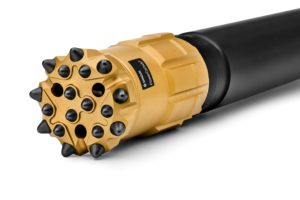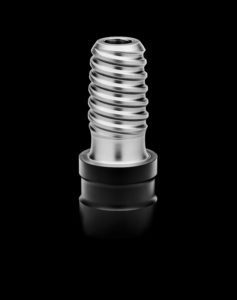Sandvik Mining & Rock Solutions through Sandvik Rock Tools sees itself as a first mover and premium innovator in rock tools, and has put these words into action again in recent years with patented solutions that have been proven to bring significant leaps in performance and productivity.
In the past few years, Sandvik has made the most significant additions to its top hammer tools and technologies line up arguably in over two decades – including a complete optimisation of its Sandvik Alpha™ thread system for underground, plus the all new CT55 and CT67 top hammer tools for surface and underground drilling. Not only that but its revolutionary Autobit for automated top hammer drilling, first introduced in 2021, has really been making its presence felt in the market, thanks to the use of patented PowerCarbide® inserts.
On a recent visit to the Sandvik Rock Tools HQ in Sandviken, IM Editorial Director Paul Moore had the chance to sit down with the top hammer product line VP as well as the product managers for both the surface and underground top hammer tools to discuss these developments in detail – why they are significant and why there are a differentiator for Sandvik.
IM Editorial Director, Paul Moore and Petter Bengtsson, Director Marketing & Communications – Rock Tools Division at Sandvik

A premium position
We started by talking to Anders Brungs, Vice President Product Line Top Hammer at Sandvik, about the group’s well earned premium market position and role. Brungs: “We are first and foremost I would say a premium tools supplier – by that we mean that we really have unique products that are patented, that bring significant added value to the customer, but also that we devote a lot of investment and time into our R&D. On the patent point, we know we are a leader as we have the most patents of any of the major rock tools suppliers globally, covering design elements, how to reduce stresses, geometry and even the tungsten carbide formulations themselves. On value to the customer this could be increased productivity or improved hole straightness, greater safety, less fuel consumption, or a combination of these.”
Brungs also pointed out how far the industry has come in terms of technology. “The standard bit and rod products and designs still being used date back to the 1950s – with these you just can’t get performance improvements. These were developed for pneumatic drill rigs running on 8 kW of power – today’s rigs use 30 kW.”
But what about those customers that are more initial cost focused, regarding tools as more of a commodity? He responded: “In any market you will have customers that are price-based buyers. We of course identify who those are and either leave those to competitors or we train them in better strategies – maybe they are not using the products correctly, or they are not using the right products, or maybe they are not understanding the full scale of costs. We have seen many customers over the years that have gone from being focused on price per piece to gradually being able to see the value of the more engineering products.” And it is also the case that differences can apply from operation to operation sense – there are very few mining companies that have global supply agreements in relation to the rock tools that they use.
Do the customers get involved in product development? Brungs: “Some do, yes. We have down a huge amount of new underground product trials in many Swedish mines, as an example, and many tests with them over the years. In many ways these Swedish mines represent a base line of technology performance for our products and of course some of the operations are quite accessible to us here in Sweden. In many cases we even know the particular drillers personally which all contributes to the quality of test results. We also do a huge amount of testing with Swedish surface contractors as well as tunnelling contractors. But much further afield we have also done a lot of work with leading mining contractors in Australia on underground mining.”
Alpha innovation in action
We then spoke to Robert Grandin, Product Manager for Top Hammer Underground Tools about Sandvik Alpha™ developments. This is a thread in the bit connection that is mainly used in mine and tunnel development operations ie with drill jumbos. It is optimised for 45 mm drilling which is the industry standard in many of the main mining markets.
Grandin: “We have had our Sandvik Alpha™ 330 system for a long time – over two decades – and while it is a fairly simple product, it has many outstanding features. It was truly groundbreaking for the time when it was developed and what could be done back then. With today’s tooling and treatment machinery combined with simulation, we are able to make big steps forward in product optimisation. We have gone from trial and error to optimisation by computing power first. We have developed a different Sandvik Alpha™ thread profile – so it is in fact asymmetric, meaning that the flank angles are different on the front and back. This hugely reduces the stress area where we have contact, as we have a contact flank in the thread where we tighten the thread, and that is where you develop the most heat and friction, so that is therefore where you see damage and breakage most often.”
Robert Grandin, Product Manager for Top Hammer Underground Tools

He adds: “Another weak point in the connection is the female connection in the bit – this sets a limit in how big the male thread can be in relation to the female. So we have made improvements internally as well by strengthening the guide section around the tightening flank to add fatigue strength, plus we have reduced the stress levels on the bit, which was then an enabler for us to increase the rod size in terms of diameter by about 1 mm, plus there is now a bigger flushing hole as well. And, last but not least, we have also made the product easier to uncouple with the pitch and flank angles that we have used.”
All of the mentioned Sandvik Alpha™ changes mean a much longer service life. But Grandin says what customers have also really appreciated is this ease of uncoupling. “Why? Because this is something that drillers notice on the very first shift.” The uncoupling itself is not yet automated but Grandin said that this is the way things will go. “We already have an automated bit changer. Rod uncoupling I would say today is semi-automated but I would fully expect full automation in the next four to five years.”
Some of the plus points from the previously available Sandvik Alpha™ 330 have been carried forward – the short thread and the guide behind it. The new Alpha product – Sandvik Alpha™ 340 – began rollout in the market in late 2022. It is applicable to rod lengths of 2.4-6.4 m; bit sizes of 43-76 mm; and reaming bit sizes of 102-127 mm. Then you have Sandvik Alpha™ 360 which has the same design changes but is larger – it combines a robust short thread with a sturdy guide system. This increases resistance to bending stresses, improves bit guidance and ensures effective energy transfer.
On market rollout he commented: “Considering that we are a major player and that Sandvik Alpha™ 330 has been our flagship product pretty much sold everywhere, it has been and is a huge project to upgrade all of these customers to the new concept. And because of the degree of higher performance and service life, Sandvik Alpha™ 330 is being completely replaced. We started this process in November 2022 and by June 2023 had reached halfway – to date this has nearly been completed. All these customers are already implementing it at site level. And while we expected some teething issues, so far we have actually had none, which is quite something for such a new product and solution. We have had at least a 30% longer service life versus competitor solutions and on average 15-20% versus Sandvik Alpha™ 330. Increased service life results in increased productivity and reduced cost per metre advanced; plus of course we have had much higher customer satisfaction because it is so much easier to use for operators.”
Sandvik’s Alpha™ 340 has an entirely new asymmetric thread

Autobit for the masses
The new thread concept goes hand in hand with improved drill bits. High performance PowerCarbide® grades are now more widely available in the standard bit assortment, with many bits having received design upgrades with more gauge angles or larger buttons for increased robustness.
But the most significant product here is Autobit. Brungs: “Automation is something that everyone is interested in. What we saw was that drilling over shift changes using autonomous drilling technology in medium abrasive ground, that the previous bits were not going to last an entire shift change. This is because the level of wear on the carbide starts to slow down drilling significantly and you need to change the bit. And actually, auto bit changers are not popular with customers as they see it as another machine with fine mechanics they need to maintain underground in often wet and challenging conditions.”
Grandin adds: “At Sandvik, we said OK, lets develop at bit which you can use for a longer period of time. We engineered the design, looking at the fundamentals – why do bits wear out, how do they wear and what stops them drilling? We changed the button design including the geometry around the buttons and not only that but also the carbide grade. In simple terms we delayed all the factors that start to make bit functionality drop off. We also reduced the amount of excess steel that can come into contact with the rock by making the insert protrude more to maximise the length of time carbide is in play. And in other areas we carved out a recess in the steel to enhance this even more.”
Autobit was designed to work with autonomous drilling and this is where it started in the market but in fact it has now been deployed in many non autonomous drilling situations as well simply due to its performance. Grandin continues: “All the things I have described are pretty attractive in non autonomous as well as autonomous drilling. The design and reduced steel area means you can drill the carbide inserts to near flat and the bit will still work. And we are utilising PowerCarbide® – while competitors have made investments in PCD technology, it comes with a much higher cost, and our unique carbide grades deliver similar performance because they drill with 30% higher drill speed. Not only that but PCD as a material does not allow you to do some of the things we have done, notably the greater insert protrusion and aggressive geometry, because by nature PCD is very sensitive to breakages.”
Autobit comes with a new, innovative bit design, which combines a strong gauge row, fully ballistic button profile and carved-out front design

He says the market for Autobit has grown exponentially since Sandvik launched it. “There is no question it has the potential to become the dominant solution in the market – you could almost rename it The Bit not just Autobit! There is no real reason to use anything else. We are seeing it for example being used in African mines that have no autonomous drills but appreciate the penetration rate and longer service life.”
In terms of use strategy in those mines that do use autonomous drilling, the idea is that when the shift is over, then you put on a new Autobit for autonomous drilling. Then you regrind it and drill it during the manual drilling shift. The grinding interval declines after several regrinds but that is all relative – the overall life improvement is still very high. This all reflects the fact that many mines operate drilling manually during normal shifts and only use autonomous mode between shifts – they are not running their drills autonomously all the time.
While Autobit was first rolled out for autonomous production ie fan drilling in stopes, in late 2023, it was also introduced into autonomous development drilling applications.
The power of PowerCarbide®
We also talked to Petter Bengtsson, Director Marketing & Communications – Rock Tools Division about the important role played by Sandvik’s in-house tungsten carbide production facility in Västberga (which was also visited by IM and will also be the subject of a follow up article): “We are really grateful for Västberga and the carbide R&D we have there – without its innovations, the new Autobit design would just not be feasible in harder rocks. The carbide development is really an enabler to us on the rock tools teams. Competitors by comparison have to buy standard carbide products on the open market. New carbide grades are traditionally made by changing the grain size and binder used. You want to achieve maximum hardness along with maximum toughness. We have moved away from the standard XT48 which have similar hardness throughout the body of the insert towards our new grades like GC81 (Gradient Carbide) and SH70 (Self-Hardening), which are based on improved knowledge about the wear of the drill bit in different types of rock.”
GC81 is developed for abrasive ground conditions with high silica levels in the rock. A new, unique method makes it possible to produce buttons that are wear-resistant on the outside, while the centre provides a toughness that pushes the service life and grinding intervals even further. SH70 is a grade with homogeneous properties throughout the material. Sandvik calls it ‘self-hardening’ because it has the ability to get more wear resistant as you drill with it, due to enhanced deformation hardening. The surface hardness is continuously ‘refilled’, which means that the hard top never wears off. The hardening effect is greatest in hard and competent ground.
So what proportion of Sandvik bits are using these new grades today? Bengtsson: “Item by item, we are phasing out the standard XT48 grade across all of our surface and underground bits. This involves SH70 on Autobit and GC81 on other bit ranges. And it isn’t limited to top hammer either – our DTH and rotary bits are also benefitting from new PowerCarbide® grades. The time taken just relates to ramping up production of the new carbide grades, getting through existing bit stocks on the customer side, switching over on our side in terms of the button production and incorporation of those into the bits, but also the sheer amount of bit products that need to be switched over such as the Retrac ranges. As well as the three to four months lead time that we give to ship to customers in many mining areas.”
A new thread following
Moving to other developments for surface tools, at CONEXPO 2023, Sandvik had a soft launch of the CT55 and CT67, whose development first began with a Sandvik engineer saying they wanted to set out to make the ‘perfect thread.’ These curved thread systems are designed for surface mining and quarrying, as well as longhole drilling underground. These systems accommodate higher drilling power than the standard ones and feature a curved profile that reduces stress levels strategically while optimising the product for fatigue strength.
Fredrik Björk, Product Manager for Top Hammer Surface Tools, told IM: “Both the new threads are built on the same technical platforms. The main reasoning behind their development was that on the typical surface crawler top hammer rigs, there was a lot of power that could not be used realistically with our standard T51 and GT60 rod systems due to too much heat limiting service life. Or put another way as our rigs got more powerful, we had to step up the drill string as well to match their performance. With CT55 and CT67 we have achieved a higher penetration rate, and good flushing performance. They allow more efficient energy transfer and have a stiff and strong connection.”
Fredrik Björk, Product Manager for Top Hammer Surface Tools

The curved thread has a bigger cross-section where it is needed, reducing stress levels, plus a more robust coupling system, allowing for easier coupling and uncoupling with double thread entrances and minimal rattling. Rattling refers to a process used to uncouple drill rods using high pressure percussion for some seconds to get them to come loose. With CT you can reduce this rattling time to 0.5 to 1 second and even saving a few seconds of rattling is critical for service life of the rods.
Björk adds: “The design of the CT (Curved Threads) means the energy is transferred from the shoulder to the female end. This means we can handle higher percussion forces. The curved thread has also allowed us to further strengthen the male and female where needed. Traditionally on top hammer threads all the wear is at the beginning and the end with the middle untouched – with the new threads the wear is much more evened out. All the new design features were run through hundreds of simulations as well as on our test rig here at Sandviken, using different pitches and combinations. Everything is also now protected by a set of new patents as well.”
Thanks to the stiff coupling Sandvik Rock Tools has also dared to also increase the dimensions – with the T51 thread, it is 52 mm with a 21.5 mm hole – its replacement the CT55 has gone up to 56 mm and opened up the hole also to 28.5 mm. “So with just a small increase in area, which is crucial as there needs to be a balance with the hammer, we have 27% higher stiffness ie it doesn’t bend meaning higher percussion and feed force. Its the same story with the GT60 and CT67, its replacement where you have a 45% increase in stiffness. Better contact with rock means better penetration.”
The formal global launch of the CT55 and CT67 took place in November 2023, for surface bench drilling but also for underground longhole drilling as well, for example underground instead of replacing the GT60, the CT67 replaces the ST68. Björk: “Our new CT system radically increases the fatigue strength and we’ve also seen 30% longer tool life together with better hole precision in our product evaluation tests with early-adopting customers. This is a fully optimised system that includes the drill rig, the rock drill and the rock tool. The CT system also brings out the full potential of Ranger™ DXi and Pantera™ DPi rigs, especially the powerful Ranger DX900i and Pantera DP1500i.”
Sandvik CT67 curved thread system

As with the Sandvik Alpha™ 330, the GT60 in particular, launched over 20 years ago, is used very widely in mining today, so the phase in process of the new CT threads will take some time. “The results again are impressive – a productivity increase of 15% conservatively as we have also seen much higher numbers in tests. Extensive use on our own rigs, from which we get very good data collection from the onboard SanRemo Mobile system, has shown we drill faster per metre and per hour. That means we are also reducing fuel consumption per drilled metre by about 15%. Plus it means a much better service life on rods and shanks of at least 30%.”
What is the value for a typical small mine or quarry or for their contractor? “With the same rig for the same time and with the same operator a contractor can invoice a significant number of additional metres drilled. Plus they are saving on fuel too. And this is based on one shift. The upside and savings in mining for 24/7 operations for presplit and contour drilling will be higher again. And for an owner operated drill fleet it means a better bottom line. Drilling metres faster and using less fuel to drill them also makes for a compelling sustainability argument as well.” In an example given to IM, using similar rigs for 89 mm holes, using T51 took 16.7 h to drill 1,000 m but CT55 took only 13.6 h. As the fuel use was similar per hour, the fuel saving really adds up.
The CT rods similar to Sandvik Alpha™ also have a bigger flushing hole. Looking at the CT shank, the shoulder is transferring a lot of the energy to the other end, so a bigger flushing hole compensates for that. The team at Sandvik agreed that the CT is such a game changer that it has the potential to boost Sandvik crawler rig sales with customers wanting to go with a Sandvik drill to get the full benefits of the tools. This also reflects the fact that you need to use the Sandvik rig to use CT on surface. As underground production drills have a more universal design it is possible to use CT technology on competitor drill rigs as well, as long as you are using the whole Sandvik drill string. Going forward, Sandvik is looking at smaller CT dimensions as well.
Finally, also worth a mention is the complete top hammer drilling system that is directly aimed as a alternative to DTH in certain applications which Sandvik refers to as Top Hammer XL – it expands the hole size range of top hammer drilling up to 178 mm (7 in). It provides a faster and more fuel-efficient drilling method that can considerably reduce CO2 emissions. The fully optimised drilling system consists of the Pantera™ DP1600i drill rig, RD1840C rock drill and LT90 rock tools. LT90 MF tube rods are developed to convey high energy shock waves with minimal energy loss in the threads.
This solution has proved very effective in hard and competent ground. For softer or fractured material, DTH still has the edge – and Sandvik offers both anyway. One option is also to use Top Hammer XL on the lower, more homogenous lower benches and DTH on the more fractured upper benches in an open pit.











